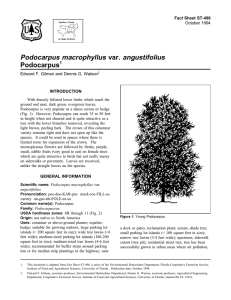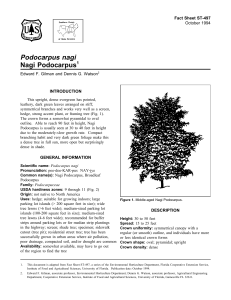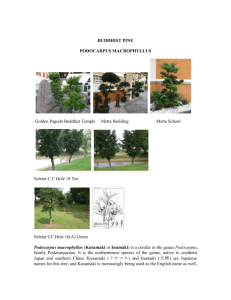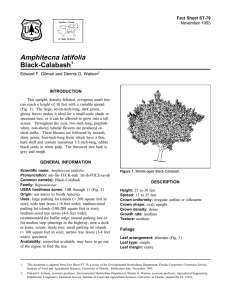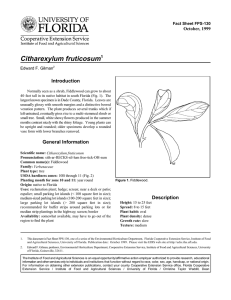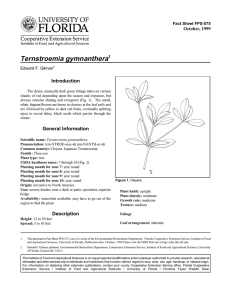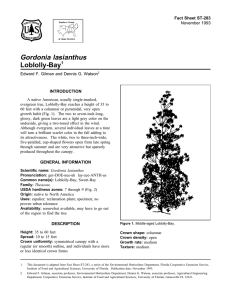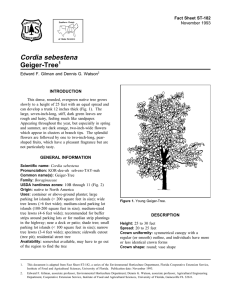Podocarpus macrophyllus Podocarpus Fact Sheet ST-495 1
advertisement
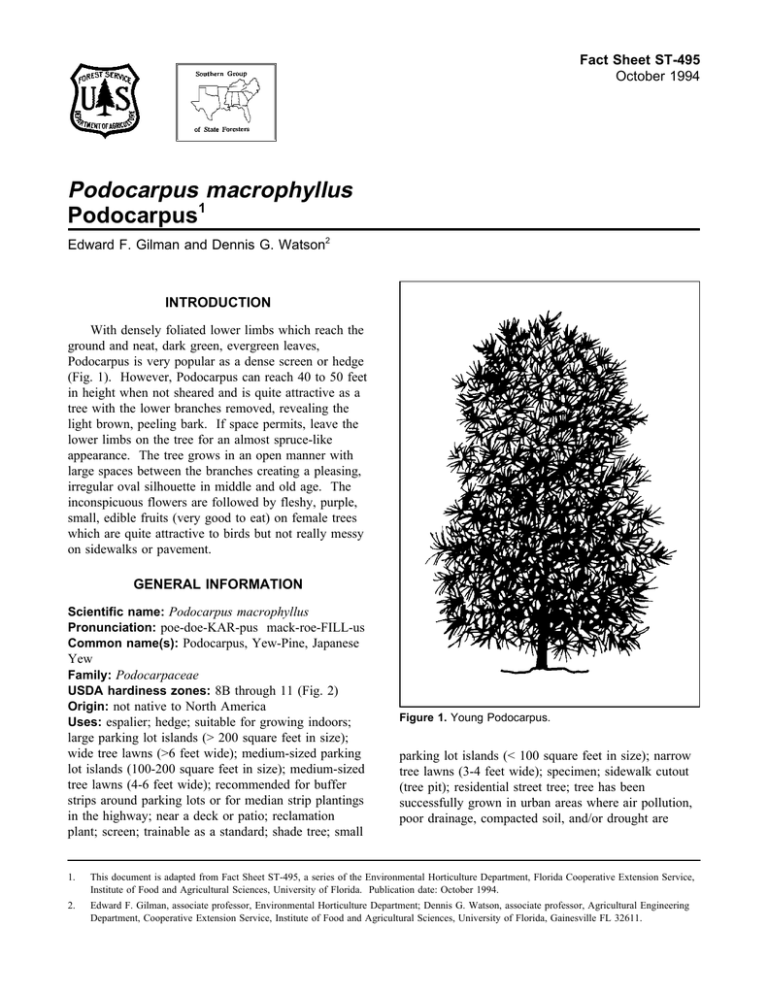
Fact Sheet ST-495 October 1994 Podocarpus macrophyllus Podocarpus1 Edward F. Gilman and Dennis G. Watson2 INTRODUCTION With densely foliated lower limbs which reach the ground and neat, dark green, evergreen leaves, Podocarpus is very popular as a dense screen or hedge (Fig. 1). However, Podocarpus can reach 40 to 50 feet in height when not sheared and is quite attractive as a tree with the lower branches removed, revealing the light brown, peeling bark. If space permits, leave the lower limbs on the tree for an almost spruce-like appearance. The tree grows in an open manner with large spaces between the branches creating a pleasing, irregular oval silhouette in middle and old age. The inconspicuous flowers are followed by fleshy, purple, small, edible fruits (very good to eat) on female trees which are quite attractive to birds but not really messy on sidewalks or pavement. GENERAL INFORMATION Scientific name: Podocarpus macrophyllus Pronunciation: poe-doe-KAR-pus mack-roe-FILL-us Common name(s): Podocarpus, Yew-Pine, Japanese Yew Family: Podocarpaceae USDA hardiness zones: 8B through 11 (Fig. 2) Origin: not native to North America Uses: espalier; hedge; suitable for growing indoors; large parking lot islands (> 200 square feet in size); wide tree lawns (>6 feet wide); medium-sized parking lot islands (100-200 square feet in size); medium-sized tree lawns (4-6 feet wide); recommended for buffer strips around parking lots or for median strip plantings in the highway; near a deck or patio; reclamation plant; screen; trainable as a standard; shade tree; small Figure 1. Young Podocarpus. parking lot islands (< 100 square feet in size); narrow tree lawns (3-4 feet wide); specimen; sidewalk cutout (tree pit); residential street tree; tree has been successfully grown in urban areas where air pollution, poor drainage, compacted soil, and/or drought are 1. This document is adapted from Fact Sheet ST-495, a series of the Environmental Horticulture Department, Florida Cooperative Extension Service, Institute of Food and Agricultural Sciences, University of Florida. Publication date: October 1994. 2. Edward F. Gilman, associate professor, Environmental Horticulture Department; Dennis G. Watson, associate professor, Agricultural Engineering Department, Cooperative Extension Service, Institute of Food and Agricultural Sciences, University of Florida, Gainesville FL 32611. Podocarpus macrophyllus -- Podocarpus Page 2 Figure 2. Shaded area represents potential planting range. common Availability: generally available in many areas within its hardiness range DESCRIPTION Height: 30 to 40 feet Spread: 20 to 25 feet Crown uniformity: irregular outline or silhouette Crown shape: round Crown density: moderate Growth rate: slow Texture: fine Foliage Leaf arrangement: alternate; opposite/subopposite; Fall characteristic: not showy Flower Flower color: yellow Flower characteristics: inconspicuous and not showy; spring flowering Fruit Fruit Fruit Fruit Fruit Fruit shape: irregular; oval; round length: .5 to 1 inch covering: fleshy color: purple characteristics: attracts birds; suited for human consumption; inconspicuous and not showy; no significant litter problem whorled (Fig. 3) Leaf type: simple Leaf margin: entire Leaf shape: linear Leaf venation: parallel Leaf type and persistence: evergreen Leaf blade length: 2 to 4 inches; less than 2 inches Leaf color: green Fall color: no fall color change Trunk and Branches Trunk/bark/branches: grow mostly upright and will not droop; not particularly showy; should be grown with a single leader; no thorns Pruning requirement: needs little pruning to develop a strong structure Breakage: resistant Podocarpus macrophyllus -- Podocarpus Page 3 USE AND MANAGEMENT This is one of a few trees which can be pruned into a nice hedge. The dark green foliage and dense growth creates a formal mass. It looks better when pruned with a hand pruner, not sheared with a hedge trimmer. Showing best growth and form in full sun, Podocarpus will grow more slowly and have a looser appearance when grown in shade. It will grow on the north side of a tall building with little or no direct sun. It will tolerate a wide variety of well-drained, acidic soils. Don’t plant on wet soils. This is a tough tree, adaptable to urban conditions and should be used much more extensively as a street tree. It should be used more in areas of poor soils and restricted rooting space. Unfortunately, most people choose to trim the tree into a column or hedge, so not many have seen the true beauty of the tree. It will make an attractive specimen, street or parking lot tree, even for the smallest soil space in a downtown planting pit. Roots are not a problem in restricted-soil planting areas and usually do not lift sidewalks. Figure 3. Foliage of Podocarpus. Current year twig color: green Current year twig thickness: medium; thick Culture Light requirement: tree grows in part shade/part sun; tree grows in the shade; tree grows in full sun Soil tolerances: clay; loam; sand; acidic; alkaline; well-drained Drought tolerance: high Aerosol salt tolerance: moderate Soil salt tolerance: moderate Many varieties are available for selection of habit, leaf form, color, etc. Podocarpus macrophyllus var. angustifolius is a narrow, columnar tree with curved leaves, 2 to 4.5 inches long; Podocarpus macrophyllus var. appressus is a low shrub with short leaves; Podocarpus macrophyllus var. maki has erect branches, columnar form, 1.5 to 3-inch-long leaves. Propagation is by seeds or cuttings. Hardwood cuttings root easily. Cutting propagation would ensure more uniform trees than seedlings. Nursery operators should be encouraged to grow Podocarpus in the single-trunked tree form for planting in urban landscapes. Pests and Diseases Other Roots: surface roots are usually not a problem Winter interest: no special winter interest Outstanding tree: tree has outstanding ornamental features and could be planted more Invasive potential: little, if any, potential at this time Pest resistance: long-term health usually not affected by pests No pests or diseases are of major concern. Occasionally bothered by scale, mites, and sooty mold but not seriously. Some magnesium-deficiency on sandy soil, which is easily corrected with magnesium sulfate.
